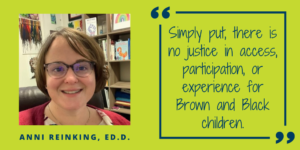I am a mother, stepmother, wife, educator, researcher, author, school board member, and so much more. However, my professional life and personal life cross paths in my identity as a white mother of a socially perceived Black son. Why “socially perceived”? He is biracial but is viewed by the world as a Black boy/man purely based on his skin color. As his mother, my advocacy, determination, and tenacity in the field of access focuses on his identity and children who share his identity — the historically marginalized population that is often left out or even forgotten because of structural -isms that are built into our society. Simply put, there is no justice in access, participation, or experience for Brown and Black children. That is the reason I decided to join the Peoria Public School District 150 school board, which leads a district in one of the poorest zip codes in the country with a high percentage of historically marginalized students (over 70% are BIPOC+ learners and over 70% qualify for free and reduced lunch). I wanted to be part of the change to provide empowering access to all students.
In the past two years, the school board has faced many challenges and brought about significant successes. When Covid-19 impacted our lives, we kept the safety of our students at the forefront of our minds. We tenaciously ensured that our students had both access to the internet, something that is not universally provided in the United States, and to food, especially those who rely on that food for nutrition and full bellies. It took time, energy, and ingenuity, but we worked to dismantle the gaps and provide opportunities. However, as a board, we did not want to stop simply with access. We also wanted to re-enfranchise students entering our buildings. When students walk into a building named after slave owners or for individuals who were known for their use of antisemitic language, it implicitly informs students that we, the entire district, “support” the injustices of the past. Therefore, we changed the names of a handful of schools, thereby providing empowering lessons to students as to the “why” of name changes.
But, why stop there? Over the past two years, we have implemented policies to ensure that historically marginalized populations are submitting for RFPs and hiring diverse teachers that represent the student body in our schools, and all students are considered when decisions are made, such as policies to handbooks and policies. For example, this past year we have intentionally changed policies to include the pronouns “they/them” rather than only “she/her” or “he/him.” Additionally, a committee recently proposed an edit to the high school dress code (elementary and middle school students currently have a uniform requirement ). The proposed dress code for high school students is fashioned after the dress code from an Evanston, IL, school that eliminates (or at least decreases) racist, classist, and sexist concepts that objectify and police bodies. The policing of bodies is based on historical factors and is highly problematic when trying to empower students in learning environments.
Through these actions, as well as many others, the school board and district have kept all students, especially those who have been historically marginalized for generations, at the forefront of providing power to access. All these actions have deconstructed -isms, including racism, in our district, a district located in one of the top five most dangerous places for Black Americans to live in the United States.
So what is the call to action? Learn, investigate, and speak. Silence is louder than words because silence quietly shows your support for the disenfranchisement of students. Investigate the -isms in your school, focus on justice by recognizing and dismantling structural issues, such as mindsets, policies, and practices, and advocate for those whose voices are not heard or valued in society. Each time you speak or share your thoughts or provide insights into how students are being left out or forgotten, someone listens and continues their own learning process on their journey of advocacy. So speak up, speak out, and speak truth to power.
Check out CT3 Education programs such as No-Nonsense Nurturer, Real Time Teacher Coaching, and Real Time Leadership Coaching to find out more about Professional Development for Teachers and Leaders, classroom management strategies, and building relationships with students and their families, and properly addressing important issues in the classroom and school.
Category: Anti-Racism



